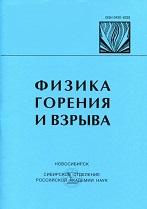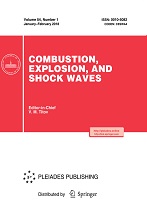|
This article is cited in 4 scientific papers (total in 4 papers)
Heat-release mechanism in ammonium dinitramide flame
N. E. Ermolin
Khristianovich Institute of Theoretical and Applied Mechanics, Siberian Division, Russian Academy of Sciences, Novosibirsk, 630090
Abstract:
To verify the adequacy of various models of heat release in ammonium dinitramide flame to real processes, chemical processes in products of thermal decomposition at a pressure of 10 torr and in ammonium dinitramide [ADN; NH$_4$N(NO$_2$)$_2$] flame at a pressure of 0.4 to 60 atm are numerically simulated. The calculations are performed on the basis of a detailed kinetic mechanism and boundary conditions correlated with experimental data, thermodynamic properties, and chemical composition of ADN. The kinetic mechanism includes submechanisms that describe high-temperature chemical processes in NH$_3$/N$_2$O/NO/NO$_2$/HNO$_2$/HNO$_3$ and NH$_3$/HN(NO$_2$)$_2$ mixtures, and the global stages of aerosol decomposition. Based on calculated and experimental data, the role of dinitraminic acid HN(NO$_2$)$_2$, aerosols, and ADN vapor in heat release in the ADN flame zone adjacent to the burning surface is estimated. The calculations predict that the main source of heat release in the cold flame zone at $p\ge$ 3 atm is dinitraminic acid incoming through the channel of dissociative evaporation ADN$_{liq}$ $\to$ NH$_3$ + HN(NO$_2$)$_2$ from the burning surface. In the high-temperature flame zone, heat release is caused by the reaction that occurs in the NH$_3$/N$_2$O/NO/NO$_2$/HNO$_2$/HNO$_3$ mixture. At moderate pressures, the high-temperature and low-temperature zones are separated by an induction zone. The stage governing production of the OH radical, which plays an important role in combustion, in the induction zone is the reaction HNO$_3$ + M $\to$ OH + NO$_2$ + M. Because of a high activation energy of the stage, small temperature perturbations in the induction zone at low pressures lead to a finite change in the stand-off distance between the high-temperature flame zone and the burning surface. Therefore, small temperature perturbations in the induction zone, which are caused by admixtures in the sample or by heat transfer between the reacting gas and the ambient medium, may be responsible for disagreement between various experimental data and between experimental and calculated data on the stand-off distance between the high-temperature flame zone and the burning surface. In numerical calculations, the position of the high-temperature zone is effectively controlled by varying rate constants of elementary stages within admissible limits.
Keywords:
ammonium dinitramide flame, simulation, kinetic mechanism, chemical processes, evaporation, heat release, aerosols.
Received: 27.06.2006
Citation:
N. E. Ermolin, “Heat-release mechanism in ammonium dinitramide flame”, Fizika Goreniya i Vzryva, 43:5 (2007), 64–76; Combustion, Explosion and Shock Waves, 43:5 (2007), 549–561
Linking options:
https://www.mathnet.ru/eng/fgv1529 https://www.mathnet.ru/eng/fgv/v43/i5/p64
|


|





 Contact us:
Contact us: Terms of Use
Terms of Use
 Registration to the website
Registration to the website Logotypes
Logotypes








 Citation in format
Citation in format 
